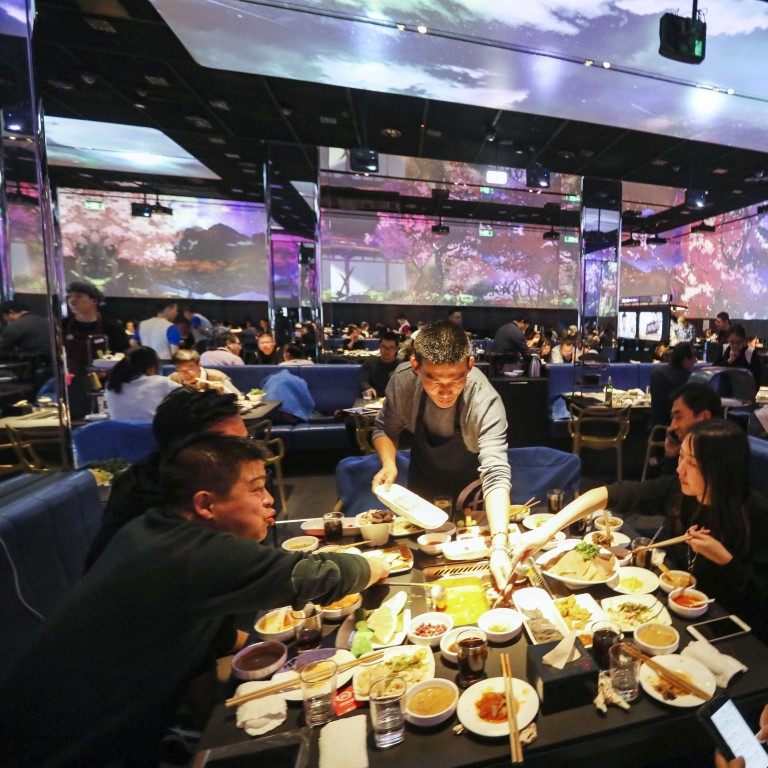
China’s restaurant industry is booming as young professionals stay hungry amid trade war, slowing economy
- China’s restaurant sector is enjoying breakneck growth and could soon overtake the US as the world’s biggest market
- Rapid growth and a tight focus on profitability make the new class of Chinese restaurant chains enticing investment targets
Chinese consumers are not allowing trade war uncertainty or a slowing economy to affect their appetite.
The country’s food and drinks sector is booming and will become a trillion-dollar industry in the next few years if it continues on its current trajectory. It could soon displace the US as the biggest catering market on the planet.
The growth engine is the increasing numbers of young professionals heading out for a late dinner or ordering home delivery after a long day at the office, according to analysts.
Jacky Wong, hospitality and services sector lead partner, Deloitte China, said people born in the 1990s contributed just over half of catering sales in 2018.
“They usually work overtime, stay up late and thus require instant gratification, leisure, and trending lifestyle. Restaurants, F&B outlets or O2O F&B delivery services are becoming their first choice,” said Wong, using an industry term meaning “online to offline”.
Data from the National Bureau of Statistics in July showed that catering revenue for the first half of 2019 rose 9.4 per cent, having climbed by a similar amount to US$628 billion in the whole of last year. Food and beverage accounted for 11.2 per cent of China’s total retails sales of consumer goods, the data showed.
It is expected to grow into a US$927 billion a year industry by 2023, according to Dr Neil Wang, Greater China president for Frost and Sullivan. The National Restaurant Association of the United States forecasts that restaurant receipts will reach US$863 billion this year.
The growth of restaurant chains in China is creating new investment opportunities – and making some founders extremely rich.
From hotpot to jackpot: Haidilao founding couple’s fortune still worth US$7 billion
“It is likely that an increasing number of China-based restaurant chains will seek listings,” said Wang. “Though the market for catering in China has reached 4 trillion [yuan] in 2018, there are not too many listed companies in the market yet.”
Since Haidilao’s HK$7.6 billion (US$970 million) initial public offering last September, the stock has doubled, giving the Beijing-based hotpot chain HK$182 billion in market capitalisation. Founder Zhang Yong’s wealth is now estimated by Forbes at US$13.8 billion.
Hong Kong-listed Xiabuxiabu Catering Management is on a growth path that resembles Haidilao’s. Xiabuxiabu refers to a style of hotpot, Shabu-shabu, which Taiwanese founder Ho Kuang-chi brought to China in 1998. His estimated net worth was US$670 million last year.
In 2012, private equity firm General Atlantic took a 19 per cent stake in Xiabuxiabu, which they hold today.
China’s hotpot king Zhang Yong becomes Singapore’s richest man
Xiabuxiabu’s 2018 revenues were US$664.6 million, much smaller than Haidilao’s US$2.4 billion. But Xiabuxiabu has seen its revenue grow 30 per cent in the past year and more than double from 2014 to 2018, while profit margins have stayed around 10 per cent or more.
The laserlike focus on profitability that’s required in the restaurant business could offer investors a way get a slice of the pie as China’s F&B industry continues to grow at breakneck speed.
“There are so many moving parts and therefore potential ways to lose money [that] being able to control these costs makes you very aware of your business and also means your standard operating systems have the buy-in of your staff,” said Ivan Fernie, who has opened seven restaurants in China and now owns an F&B consultancy in Hong Kong.
The rapid expansion of both Haidilao and Xiabuxiabu will push those systems to the limit. Using funding from its IPO, Haidilao boosted the number of its restaurants from 273 to 466. In 2018, Xiabuxiabu opened 195 new restaurants to bring their total to 934.
Rising costs and expansion would encourage successful chains to seek listings or investments in order to upgrade their operations, said Wang.
Jacky Wong said the success of chains like Haidilao and Xiabuxiabu was down to their embrace of data-driven supply chains and centralised kitchens.
Meanwhile, Hong Kong-based restaurant companies are trying to crack the China market to offset tough conditions at home.
Café de Coral, a family-owned restaurant chain that’s been running for half a century, earns 85 per cent of its revenues in Hong Kong. But domestic growth has been flat for two years, while Café de Coral’s revenue from mainland China has jumped 7 per cent. The company is expanding its network of restaurants in China, and plans to open 20 more in the coming year.

